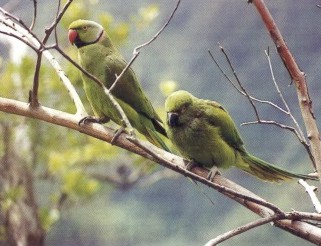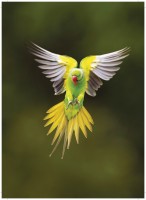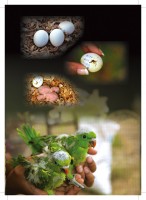The Parrot Society UK
Echo Parakeet Conservation Project
ECHO PARAKEET CONSERVATION PROJECT©
Supported by The Parrot Society UK

Echo Parakeet
CONSERVATION REPORT 1999 - 2000©
- 1999 - 2000 has been a great breeding season for the world's rarest parakeet! Despite some early season stress caused by the Echoes starting to breed early and before the full Echo field team had arrived, things have gone very well. The field team was able to find and monitor 19 nests through the season. A single additional nest was found at the end of the breeding season (December).
- 20 wild nests - 37 eggs - 29 hatch. Of the 20 females that attempted to breed 12 were able to rear young to fledging. The Echo team monitors wild nests every 2 days for the first 10 - 15 days and then every week until fledging. This allows them to remove chicks that are not doing well, either fostering them with other wild birds or bringing them to the captive-rearing team at the Gerald Durrell Endemic Wildlife Sanctuary (GDEWS).
- A total of 37 eggs were laid by the 20 breeding females monitored this season and 29 of these hatched. Four eggs in one nest were all infertile, a fairly common occurrence in young parakeets who go through a steep learning curve in their first 1 or 2 breeding seasons.
- 40% chick mortality - can be further reduced, Sadly 12 of the 27 hatched chicks died; 3 of which starved. Some mortality is natural in any population but we need to minimize it, especially since we are still in the early stages of recovery of this critically endangered parakeet.
- Blood-sucking flies suffocated 4 chicks. An individual fly can block the nostrils of a new chick. The field team usually treats all nest cavities with insecticide treated wood-shavings, but due to the early flush of broods they were not able to treat them all in time this season.
- Another 3 chicks were killed by Tropic Birds. These are the main competitors of Echoes for nest sites, which are cavities in emergent canopy trees. Lance Woolaver (Echo Team Leader) is now spending his winter season modifying the cavities that Tropic Birds compete for. He is covering the old large entrance holes, and drilling a smaller Echo-sized one for each cavity on the opposite side of the trunk. This technique has been proved successful in previous years.
- Most distressing were the 2 chicks that were mutilated by their father. Such tragic neurotic behaviour is a common occurrence in parrots that have been captive-raised without the essential natural socialization with other parrots. This was difficult to avoid in the earliest days of our captive breeding programme because there were so few Echoes. To-day the captive - breeding team is making all efforts to allow birds to socialize in captivity. Next season they will also trial earlier weaning for hand-reared chicks.
- Success with chick pairs, fostering and dummy eggs. This year was the first time that the field team experimented with leaving 2 chicks per nest for experienced wild pairs to raise, with great success. A total of 6 wild pairs were able to raise and fledge 2 chicks each! The use of dummy eggs to keep one pair waiting after their young chick had been killed by tropic birds, allowed the team to successfully transfer a starving chick from a large brood to be raised by them - another world first for parakeet conservation management!
- In all 3 chicks were fostered to other wild parents and 4 chicks and 3 eggs were transferred to the GDEWS captive rearing team. The total of 17 chicks raised in the wild is up 6 on last year, and brings the total wild population to between 106 and 126 Birds! Accurate estimates are difficult to make for Echoes in comparison with the Pink Pigeons because the parakeets population is spread out amongst deep gorges and areas that are difficult for even the toughest of Echo workers to access!
- Captive breeding - a boys only year. In the 10 years that MWF has been working to save the Echo Parakeet the various Echo teams have worked incredibly hard. The captive - rearing team especially has had to feed tiny chicks every 2 hours from dawn to midnight in the earliest stages. Ending up with the fatigued appearance of parents of a newborn human. Sleep cannot be sacred to these dedicated technicians! This year the captive-rearing and captive-breeding team, (Emma, Araxia, Marie-Michelle and Freddie) hand reared 4 wild chicks and 3 captive bred chicks, and captive birds reared 2 more wild chicks and 1 of their own chicks.
- One problem in the wild population of Echoes is it has a significantly male-biased sex ratio. This may be due to chance bias when the population was very small, or perhaps due to higher female mortality. Female birds are the ones with the Y-chromosome, so they have greater chances of having sex-linked genetic problems. In order to rebalance the wild sex ratio we decided that this year we would only release female captive-bred Echoes, in order to bump up the proportion of females in the wild. Genetic sexing tests showed that this year 9 out of 11 tested wild-reared chicks were females and all the chicks that were captive-reared were male (we await another 8 wild chick results). With all the captive-reared chicks being male, there was no need for any releases!
- Zoos to receive Echo males. Pending government permission, we should now be able to send 7 male captive Echo parakeet ambassadors to international zoos. There they can help raise awareness on the plight of their species, as well as giving important handling practice to keepers who may in the future be responsible for an international captive-rearing programme.
- What a recovery - Over 100 wild Echoes from just 21. So the Echo Parakeet Conservation Programme is going from strength to strength. With more birds than ever now breeding successfully in the wild - remember that's an estimated 106 to 126 echo parakeets in the wild! A fantastic recovery from a tiny population of just 12 birds back in 1984. We are all very proud of our achievements and very thankful for all the financial support we have had over the years from THE PARROT SOCIETY UK and other donors. We could have not done it without your support!


Echo Parakeet in flight; collage of eggs and chicks (PSUK)
NEW CHALLENGES IN ECHO CONSERVATION
- Wild population: nest modification, nest boxes, down-sizing and fostering. Next breeding season MWF's Echo team will continue to downsize nests with the emphasis once again on producing as many wild-reared fledglings as possible each season. As more Echo Parakeet pairs join the wild population we will also start to provide artificial nesting shelters specifically designed for the Echoes, to boost the number of available nesting sites. Modification of nest sites to deter competition by Tropic Birds will also be important.
- The increasing number of wild Echoes will probably also make it necessary for the field team to focus on a portion of the wild nests instead of the entire population, as the number of breeding pairs may well be too many to monitor all of them intensively. The Echo field team will therefore have to adjust to a new set of criteria for their monitoring.
- Captive-breeding and hand-rearing: new techniques, brooders and laboratory. Our captive-rearing and release programme will continue to play a crucial role in augmenting the wild population with captive reared chicks from downsized nests. A new development this season has been the successful production of entirely captive-bred Echoes from hand-reared captive pairs. These pairs are able to court in a new super-aviary at GDEWS. This new aviary has incorporated a special new parakeet flight area were Echoes can meet and choose their own mates. We therefore have great hopes for increased captive-breeding production in the coming seasons.
- The next season's captive-rearing will bring exciting new developments in the earlier socialization and weaning of captive-reared chicks. However, current hand-rearing facilities do limit the number of birds and quality of hand-rearing that can be achieved. The hand-rearing room is a small converted outhouse with space for only up to 5 chick cages and severely limited opportunities for environmental enhancement. The brooders used are very basic temperature-regulated boxes. As explained above we do observe quite severe behavioural problems amongst our hand-reared Echoes. It is therefore a priority to upgrade the hand-rearing facilities to provide for a larger volume of production and in more diverse and naturalistic conditions.
- Ideally the hand-rearing will be eventually be sited in a specifically designed dedicated Echo Parakeet captive-rearing laboratory. Our immediate aim is to provide Lyon's brooders for the early stages of hand-rearing, so that chicks will be able to see other parakeets rather than being reared in effective isolation chambers. By combining this with earlier weaning and use of environmental stimuli such as Echo puppets for hand-feeding, we hope to significantly improve the early socialization and environment of the hand-reared Echoes.
AKJ 2018 - another interesting article on a working and successful conservation project, but updated current information would be welcome.
Donations
Any persons wishing to make a financial contribution towards the Conservation Fund may do so online at Donate to The PSUK Conservation Fund or in the form of a crossed cheque or International Bank Draft in Pounds Sterling made payable to The Parrot Society UK, and post to :-
CONSERVATION FUND,
THE PARROT SOCIETY
UK Audley House
Northbridge Road
Berkhamsted
Hertfordshire
UK HP4 1EH
Telephone/Facsimile No.: (44) (0) 1442 872245
We will be pleased to receive further articles and information of interest to add to our Web Site or for publication in our Magazine. Please forward by post or by E-Mail to The Parrot Society UK for the attention of The Webmaster. We review all submitted articles and the society reserve the right not to publish articles at their discretion. Their decision is final in all these matters and no further correspondence will be entered into.
Articles marked with the copyright symbol© beside the author`s name are copyright© the author. In these cases, copyright remains with the author/authors and the information cannot be reproduced without the additional permission of the said author/authors.
